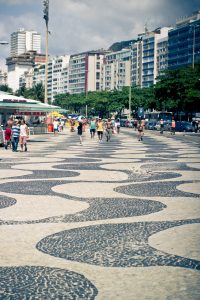 “Slow death to the infamous Portuguese who invented the Portuguese pavement. Cursed d. Manuel 1st and his gang of lieutenants Eusébios. Irregular square boulder crushed by hand. By hand! Of course it would break loose, no one noticed it was going break loose? White, black, white, black, the waves of Copacabana. Who cares about the waves of Copacabana? Give me a flat floor, without limestone lumps. Stupid mosaic. Mosaic mania. Just throw concrete on top of it and flatten. Hole, crater, rubble, bomb manhole. After the seventy years old life becomes an endless obstacle course”. Álvaro (from the book “FIM”, by Fernanda Torres, in Portuguese, own translation).
“Slow death to the infamous Portuguese who invented the Portuguese pavement. Cursed d. Manuel 1st and his gang of lieutenants Eusébios. Irregular square boulder crushed by hand. By hand! Of course it would break loose, no one noticed it was going break loose? White, black, white, black, the waves of Copacabana. Who cares about the waves of Copacabana? Give me a flat floor, without limestone lumps. Stupid mosaic. Mosaic mania. Just throw concrete on top of it and flatten. Hole, crater, rubble, bomb manhole. After the seventy years old life becomes an endless obstacle course”. Álvaro (from the book “FIM”, by Fernanda Torres, in Portuguese, own translation).
If you don´t speak Portuguese, you might have never heard about the “Portuguese pavement”. However, if you have ever been to, or plan to visit Rio de Janeiro, or Lisbon, the Portuguese pavement will be hard to ignore.
This fantastic piece of city technology is a heritage of Roman culture, developed by Portuguese during the XIX century and exported to different parts of the lusophones’ world during Portuguese colonial rule. It is the use of cubic pieces of stone, set by hand side-by-side to finish the pavement. The Portuguese pavement often has different stone colors, forming images and motives, such as the famous Copacabana waves.
Despite its widely recognized cultural value, this type of pavement is at risk of extinction, and can be an interesting example of the potential dilemmas that can arise from age-friendly initiatives.
In fact, the death of the Portuguese pavement might have started early March 2015 when a traditional neighborhood in Lisbon voted for the replacement of the traditional sidewalk pavement for a more modern and safe floor cover.
The technical features of different city technologies might lead us to an interesting debate on permeability, maintenance costs, environmental impact, etc. Yet the cultural dilemma is also an important topic to consider and, unfortunately, often overlooked when decisions are rushed to make way to “modernity”.
Keeping in mind the fact that falls and the associated complications are among the most serious problems that face older persons, how can we compaginate this important cultural asset with the need to adapt the cities?
